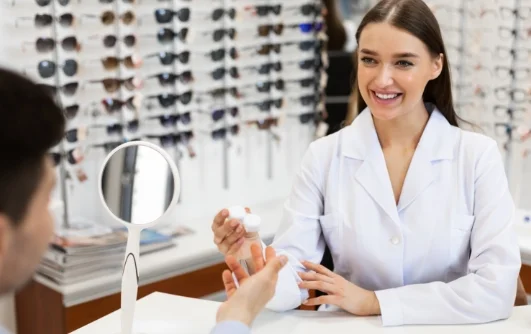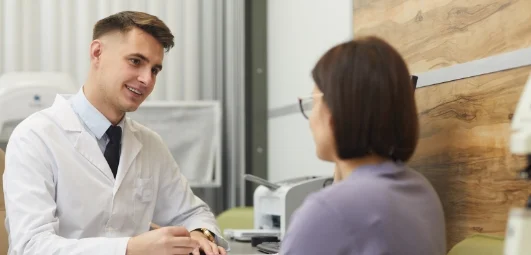Amblyopia
Amblyopia means that one eye's vision is not as good as the vision in the other eye. This is due to a weakness in the pathways connecting the eyes to the brain's vision centres. Amblyopia is commonly referred to as "lazy eye." Typically, amblyopia starts during childhood and is one of the most common causes of vision loss in children. However, with early treatment, you can prevent most long-term vision problems.
Causes Of Amblyopia
There are many causes of amblyopia. The main causes include:
- Strabismus (Crossed Or Out-Turned Eyes).
- Significant Refractive Errors (Severe Nearsightedness, Farsightedness Or Astigmatism).
- Partial Or Full Obstruction Of Visual Images Reaching The Back Of The Eye, Due To Cataract, Corneal Opacity, Or Droopy Eyelid.

Treatment Of Amblyopia

Amblyopia is potentially reversible by treating any correctable causes and forcing the weaker eye to work harder than the good eye. The earlier this treatment starts, the more successful it is. In general, it will work well in children less than eight years of age. In most cases, after age 8-10 years, the vision 'sticks' because the vision pathways mature and become resistant to changes. However, some newer studies are showing promising results in teenagers with amblyopia who were never treated previously. So, earlier is better, but don't give up too soon!
To stimulate the amblyopic eye, we patch the non-amblyopic eye (the good eye).
Using Eye Patches
Eye patches (brand names are Coverlet, Opticlude, or Ortopad) can be purchased at most drug stores or here at the office, where we supply more affordable, child-friendly patches. The patches are available in two sizes (junior and regular). Use the larger size (regular) if your child is two years or older.
The patch should be placed directly on the skin and must completely cover the normal eye. If prescribed, children should wear glasses over the skin patch. Trying a different type of patch or changing the shape of the patch may relieve skin irritation. The patch can be removed using some warm water to soak off the glue - bath time often works well for this. A pirate patch over the normal eye is not good enough. However, special patches that fit over glasses are available as maintenance therapy once the vision has improved sufficiently. These cloth patches are available at the office.
Patching should be done during waking hours and preferably during visual tasks (such as reading, drawing, TV, or even video games) performed by your child. Try to avoid patching during nap times to reduce skin irritation. If your child has poor vision in the lazy eye, please avoid unsupervised playing outdoors or in any potentially unsafe area while the normal eye is being patched.
If the child cannot wear the patch, then we may have to switch to using Atropine eye drops.
Atropine Eye Drops
Atropine has two effects: One is that it dilates (enlarges) the pupil. This effect can last several days. The second effect is that it paralyzes the focusing muscles to blur the vision. This blurring effect is essential for your child's treatment and wears off in about 24 hours after the drop is given. Therefore, it is essential to use the drops as directed, even if the pupil is dilated.
Atropine drops have several side effects and require certain precautions:
- The Drops May Sting A Little.
- The Pupil Will Enlarge & The Eye May Be Sensitive To Bright Light.
- The Eye May Become Slightly Red.
- Your Child's Face May Become Flushed.
- If Your Child Develops A Fever, You Should Stop The Atropine Drops & Give Children's Tylenol.
- Please Keep The Atropine OUT OF REACH OF CHILDREN, As There Is Enough Medicine In The Bottle To Harm Any Child Who Ingests The Contents Very Seriously. If You Are Concerned Regarding Ingestion, Call Poison Control At 403-944-1414, Or Health Link At 811.
- Be Sure To Wash Your Own Hands Before & After Administering The Drop To Ensure That You Do Not Contaminate Your Child's Other Eye Or Your Own
If you have any concerns about the Atropine drops, stop using the drops and call our office the next working day. We are more than happy to address any of your concerns about amblyopia treatment.
Regular follow-up visits are essential throughout amblyopia treatment to be sure that all is going well. A small number of children can develop strabismus (misalignment) of their eyes which becomes unmasked by the use of Atropine or patching. Also, the vision in the normal eye can decrease a small amount as a side effect.
Contact Us To Book Follow Up